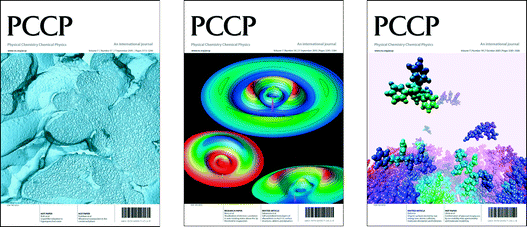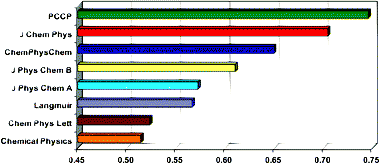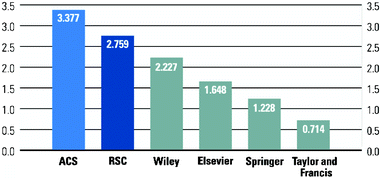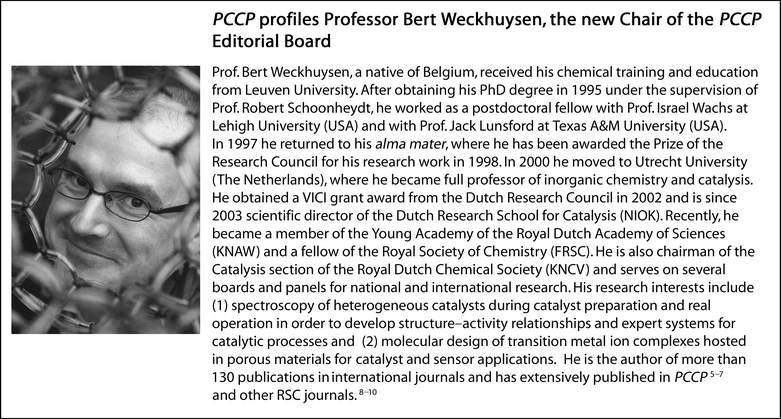Building on PCCP’s success–weekly publication in 2006
Happy New Year to all our readers around the world!
On behalf of the PCCP Editorial Board and the PCCP Owner Societies, we welcome you to this first issue of PCCP in 2006.Weekly publication
The year ahead is an especially exciting year for PCCP. It is a mark of the success of PCCP and the community that it serves that the journal will increase in frequency and will be published weekly this year. As detailed in the January 2005 editorial1 the journal has undergone considerable growth since its launch in 1999, and it is this growth—and the support of our authors and referees—that has enabled us to move to weekly publication. The editorial policy of the journal2 continues to be to publish only the best of the work submitted within the scope of the journal. PCCP receives a large quantity of high quality papers from our authors and this is the principal driver for moving to weekly publication.Cover design and formatting
From January 2005 a new cover design for PCCP was introduced and this has been enthusiastically received by authors and readers alike. The opportunity to promote work on the cover or inside front cover has been very popular with authors, with much competition for these top spots (see Fig. 1 for examples). We do encourage authors to send suggestions for covers with their manuscript. Authors who have their work featured on the covers receive hard copies of the cover and also the electronic file to use in presentations, etc. In addition the covers are promoted widely on our web pages including the PCCP home page, the contents pages, and the cover gallery. | ||
| Fig. 1 Covers from 2005 (a) Cover picture from Ingrid Kohl et al. (issue 17); (b) cover from R. Stephen Berry et al. (issue 18); (c) cover from Arnaud Delcorte (issue 19). | ||
This year with the move to weekly publication we have taken the opportunity to change the design of the journal articles to make each article even more attractive to read. We are also introducing a new ordering system on our website to further enhance the online browsing of content. We hope that you will enjoy reading the journal every week and find the new format easier to read, both in print and on the web.
High impact and immediacy index
In June 2005 we were delighted when newly-released ISI® citation data showed that PCCP had the highest immediacy index of any general physical chemistry journal during 2004 (Fig. 2). The immediacy index is a measure of how topical and urgent the papers published by a journal are, and is calculated by dividing the number of citations to articles published in a given year by the number of articles published in that year. In principle the immediacy index could be seen as an indication of the level of the impact factor in years to come. The 2004 PCCP immediacy index was 0.745—higher than any other general physical chemistry journal, and more than double the ‘physical chemistry’ subject category aggregate index of 0.381. We would like to thank all of our authors, referees and readers for making this happen. The PCCP impact factor also rose for the fourth consecutive year. | ||
| Fig. 2 Comparison of 2004 immediacy indices as published by ISI®. | ||
It is worth noting that alongside the ACS Publications, journals from RSC Publishing have the highest median impact factor among publishers in the chemical sciences. This encouraging statistic demonstrates the recognition and status that researchers place in society published work (Fig. 3).
 | ||
| Fig. 3 Median impact factor in seven ISI® core chemistry categories. | ||
Our quickest ever paper
PCCP continues to recognise the importance many authors attach to the rapid publication of their work. The journal is well-known for being the quickest physical journal, and our long-term trends to increasingly quicker publication have continued over the past year. In June we published a full paper3—by Fred Manby and coworkers—less than nine days after receipt! This incredibly short publication time made it our fastest ever paper, and was achieved without compromising on the peer-review process. As ever, all papers published in PCCP receive at least two reports from our international panel of referees.Editorial board changes
Five Editorial Board members (Professors Mike Ashfold, Martin Head-Gordon, Giovanni Marletta, Helmuth Möhwald and Stuart Rice) completed their respective terms of office at the end of 2005, and receive our sincere appreciation for their substantial contributions to the success of the journal. We would like to single out Professor Mike Ashfold for a special mention. The end of 2005 saw the retirement of Mike as Chair of the Editorial Board. Mike has served as Chair for the past three years, and has been an Editorial Board member since the journal’s launch in 1999. He has contributed a huge amount to the journal over the years, publishing many papers in PCCP himself, and has been one of the key figures in helping PCCP to establish itself as the premier European based physical chemistry/chemical physics journal. It is fitting that this issue contains an Invited Article written by Mike and co-authors.4 High quality Invited Articles have long been one of the most popular aspects of PCCP, and readers can look forward to many more over the coming year. The new Chair, Professor Bert Weckhuysen, has been a member of the PCCP Editorial Board since 2003. A profile is included at the end of this editorial. Bert says “It is a great pleasure and an honour for me to take on this role, and I am looking forward to building on the considerable achievements of my predecessor.”There are five new members of the Editorial Board from 2006, and we are delighted to welcome Professors Bernie Binks, Pekka Pyykkö, Piergiorgio Casavecchia, Vincenzo Schettino and Martin Suhm, who bring a wealth of experience from different areas of research. Profiles of each new Editorial Board member will appear in subsequent issues. It also gives us great pleasure to welcome nine new members to our International Advisory Editorial Board: Professors Peter Gill, Andrej Sobolewski, Sabine van Doorslaer, Todd Martinez, Zhongqun Tian, Can Li, Seong Keun Kim, Toshio Kasai and Roi Baer. We also extend a warm welcome to Professor Joshua Jortner who joined the PCCP Honorary Board during 2005. Full details of the PCCP Honorary, Editorial and Advisory Boards can be found on our website, www.rsc.org/pccp.
Technological advances
2005 has seen RSC Publishing invest significantly in technological developments across all of its products. First there was the introduction of the new website in the summer which included a contemporary, fresh look and an enhanced structure for improved and intuitive navigation between relevant, associated content. The improvements to the technological infrastructure have made the site more flexible and efficient, and better equip the RSC to deliver enhanced publishing products and services for its customers in the future. The new look was just the start and towards the end of the year we were pleased to provide further enhancements in the form of RSS feeds and ‘forward linking’ facilities.RSS, or ‘really simple syndication’, is the latest way to keep up with the research published by the RSC. The new service provides subscribers with alerts as soon as an Advance Article is published in their journal of choice. Journal readers simply need to go to the journal homepage, click on the RSS link, and follow the step-by-step instructions to register for these enhanced alerts. RSS feeds include both the graphical abstract and text from a journal’s contents page—i.e. they deliver access to new research straight to a readers PC, as soon as it is published! Many feed reader software packages also have the added benefit of remembering what has been read previously, which in turn makes tracking and managing journal browsing more efficient.
‘Forward linking’, the reverse of reference linking, enables readers to link from any RSC published paper to the articles in which it is cited. In essence, it allows researchers to easily track the progression of a concept or discovery, since its original publication. With one click of a button (on the ‘search for citing articles’ link) a list of citing articles included in CrossRef is presented, complete with DOI links. At a time when research is becoming increasingly interdisciplinary in nature and the amount of published work continues to grow, it is hoped that the new technology, developed in conjunction with CrossRef, will significantly reduce the time spent by researchers searching for information.
These developments demonstrate the investment in publishing products and services over the past year and 2006 will see us enhancing our products further, with improvements to the HTML functionality of all journals and ReSourCe (the author and referee web interface) already underway.
Soft Matter
Following its successful launch in 2005, the RSC’s new monthly journal Soft Matter goes from strength to strength. Providing a forum for the communication of generic science underpinning the properties and applications of soft matter, many top authors from prestigious organisations around the world have already submitted articles. The journal has been very well-received in the community-and subscribers to PCCP in 2006 will continue to receive free online access to this exciting new addition to the RSC portfolio.Finally
We would like to express our thanks to everyone who has supported PCCP, both by contributing excellent papers and providing valuable and speedy referees’ reports. The reputation of the journal, and ultimately its continuing success, is dependent on the quality of work submitted by supportive authors and the reports provided by dedicated referees.As always, we welcome your suggestions as to how the journal might be improved or enhanced further; if you have any suggestions please send them to the editorial office at pccp@rsc.org.
We wish you all every success in 2006!
Bert Weckhuysen
Chair, Editorial Board
Susan Weatherby
Editor
Philip Earis
Deputy Editor
References
- M. Ashfold, S. Appleyard and P. Earis, Phys. Chem. Chem. Phys., 2005, 7, 11 RSC.
- M. Ashfold and S. Appleyard, Phys. Chem. Chem. Phys., 2004, 6, E9 RSC.
- A. J. May, E. Valeev, R. Polly and F. R. Manby, Phys. Chem. Chem. Phys., 2005, 7, 2710 RSC.
- M. N. R. Ashfold, N. H. Nahler, A. J. Orr-Ewing, O. P. J. Vieuxmaire, R. L. Toomes, T. N. Kitsopoulos, I. A. Garcia, D. A. Chestakov, S.-M. Wu and D. H. Parker, Phys. Chem. Chem. Phys., 2006, 8, 26 RSC.
- B. M. Weckhuysen, Phys. Chem. Chem. Phys., 2003, 5, 4351 RSC.
- F. Morales, D. Grandjean, F. M. F. de Groot, O. Stephan and B. M. Weckhuysen, Phys. Chem. Chem. Phys., 2005, 7, 568 RSC.
- S. J. Tinnemans, M. H. F. Kox, T. A. Nijhuis, T. Visser and B. M. Weckhuysen, Phys. Chem. Chem. Phys., 2005, 7, 211 RSC.
- B. M. Weckhuysen, Chem. Commun., 2002, 97 RSC.
- A. M. Beale, A. M. J. van der Eerden, K. Kervinen, M. A. Newton and B. M. Weckhuysen, Chem. Commun., 2005, 3015 RSC.
- C. N. Nenu and B. M. Weckhuysen, Chem. Commun., 2005, 1865 RSC.
| This journal is © the Owner Societies 2006 |

